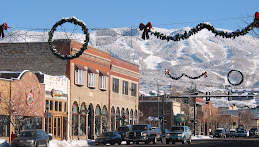Steamboat 700 pledges dollars to identify workforce, demand
By Brandon Gee - Steamboat Pilot
Friday, February 15, 2008
Steamboat 700 by the numbers
Size: 700 acres
Buildout: 10 to 25 years
Residential units: 1,827 to 2,243
High-density residential units (condos, townhouses, apartments): 45 percent
Small, single-family lots (under 8,000 square feet) or duplexes: 36 percent
Square footage of commercial/nonresidential uses: 272,000 to 331,000
Affordable housing target: 80 percent to 150 percent AMI (area median income)
Permanently deed-restricted housing provided by developer: 20 percent (367 to 448 units)
Topography: Most slopes 5 percent to 15 percent, some 30 percent or more on bluffs and hillsides
“Village centers:” three to four stories
Open space: 221 acres (32 percent)
Trails: 10+ miles
Infrastructure cost: $103 million
Additional off-site automobile trips a day generated: 14,000
— Source: Steamboat 700 Initial Submittal, November 2007
Steamboat Springs — The Steamboat 700 development team hopes to put some faces to the numbers that are thrown around in discussions about affordable housing.
The West of Steamboat Springs Area Plan, which provides community development guidelines for land including the Steamboat 700 parcel, requires developers to provide 20 percent of their homes as affordable housing to people who make an average of 80 percent of the area median income, or AMI. Steamboat 700 proposes to target an average of 120 percent of AMI. The discrepancy has created conflict between developers and the city. It also has many wondering — whether the target is 80 percent or 120 percent — who the housing will actually serve.
“The housing plan should focus on housing people, not statistics,” Peter Smirniotopoulos, Steamboat 700’s housing consultant, said at the project’s pre-application review before the Steamboat Springs Planning Commission on Thursday. “The purpose, as we understand it, is to provide housing for the workforce.”
Steamboat 700 principal and Project Manager Danny Mulcahy said his emphasis on a higher income bracket is based on research of the community. The research suggests the workforce that Steamboat officials are interested in retaining earns more than 80 percent of AMI.
“We believe the community housing plan should consider housing needs beyond 80 percent of AMI,” Smirniotopoulos said.
To help personalize the statistics, Peter Patten, a land-use consultant employed by Mulcahy, said Steamboat 700 will fund one-third of the cost for a “comprehensive demand analysis to identify the breadth and depth of the community’s need for workforce housing.” The city and Yampa Valley Housing Authority would partner in the study.
During public comment at Thursday’s meeting, Noreen Moore said the city’s policies might be too focused on service industry employees, rather than young professionals who might make as much as six figures but still can’t afford to live in Steamboat Springs. She said companies like TIC are very important to Steamboat and that rapidly rising home prices are “a real threat to economic diversity.”
“I’m asking you to help the industry sector we don’t see but that is very important to us,” said Moore, business resource director for the Routt County Economic Development Cooperative.
Housing considerations have dominated discussions about Steamboat 700. Planning Services Manager John Eastman said that is because affordable housing is the most pressing community need that needs to be addressed in west Steamboat development, and as a condition of the annexation requested by Steamboat 700 developers.
“We want a real community,” Eastman said. “The fundamental community contract was that we get this part right.”
skip to main |
skip to sidebar



Ski Town USA
Downtown Steamboat
Blog Archive
-
►
2012
(3)
- ► April 2012 (3)
-
►
2010
(5)
- ► December 2010 (1)
- ► February 2010 (2)
- ► January 2010 (1)
-
►
2009
(42)
- ► September 2009 (3)
- ► April 2009 (2)
- ► March 2009 (15)
- ► February 2009 (4)
- ► January 2009 (9)
-
▼
2008
(210)
- ► December 2008 (12)
- ► November 2008 (8)
- ► October 2008 (17)
- ► September 2008 (34)
- ► April 2008 (13)
-
▼
March 2008
(31)
- EDGEMONT - STEAMBOAT'S NEWEST DEVELOPMENT
- Steamboat's New Development - Porches (All Season)
- Edgemont (Formerly Bear Claw III) Slopeside - Stea...
- Steamboat 700 - Possible 200 Homes in 2010
- Understanding mountain real estate during a nation...
- Understanding Steamboat's market, mortgage rates, ...
- The Porches - Steamboat Economy - Vail Housing
- Wildhorse Marketplace Restaurants
- Town is Packed with Guests
- City Evaluates Iron Horse Proposals
- Post Office Could be Moving
- Community Center Opening Soon
- January Sales Volume Falls
- New Project - St. Cloud Resort & Spa (Entrance to...
- Understanding Steamboat's Housing Needs
- Holy Name Caught in Historic Preservation Issue
- Lawsuit Filed Against 700
- City Seeks 700 Team
- Mount Werner Circle & Apres Ski - Future Traffic R...
- New Project - Sundance North
- Steamboat 700 Pledges Dollars to Identify Workforc...
- Ski Time Square Demolition Scheduled for Summer
- Road Costs
- Stamboat to end 2007-2008 Ski Season on April 6th
- Sheraton to Remodel / Ski Time Square News
- Opinion - Paul Hughes: A managing vote
- Opinion-Steve Aigner: Annexation review
- Edgemont - New Ski in/out Development in Steamboat
- 700 team floats metro district
- Council delays action on design standards for affo...
- Steamboat 700 Traffic Plans Review
- ► February 2008 (7)
- ► January 2008 (25)
-
►
2007
(37)
- ► December 2007 (14)
- ► November 2007 (17)
- ► October 2007 (6)
Subscribe To News
Learn more about Steamboat Springs, CO
About Me

- Michelle Diehl
- To learn more about Steamboat Springs. Visit my website: www.SteamboatDream.com
Thank you for visiting the Steamboat Springs, Colorado, Real Estate News Site
Visit www.steamboatpilot.com for more news.

Ski Town USA